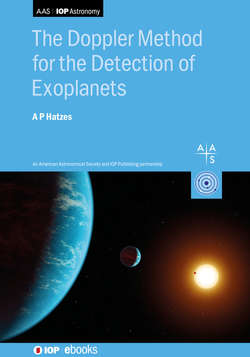Читать книгу The Doppler Method for the Detection of Exoplanets - Professor Artie Hatzes - Страница 15
На сайте Литреса книга снята с продажи.
1.6 The Doppler Method
ОглавлениеThis book is written primarily for astronomers who wish to use the Doppler method for the detection of exoplanets. Given the ubiquity of Doppler measurements in astronomy, its utility is not restricted to this narrow field. Measurement precision is only one aspect of the process.
The redshift z of an object is defined as
z=λmeasλemit−1,(1.3)
where λmeas is the measured wavelength of the spectral feature and λemit is the emitted wavelength.
We are interested in the nonrelativistic Doppler shift, and if the change in wavelength is Δλ = λmeas−λemit, then the Doppler shift can be converted to an RV by
So, in principle, the method is quite simple. You measure a position of a spectral feature, compare it to its rest wavelength, and convert that to a Doppler shift in velocity using Equation (1.4). Once you have sufficient velocity measurements, you can fit a Keplerian orbit and derive the companion mass. Simple in theory, but as we shall soon see, challenging in practice.
The Doppler method we will deal with in this book is strictly a relative, as opposed to absolute, velocity measurement of stars. To detect companions to a star, we just need the relative Doppler shift with respect to a fiducial spectrum, either a standard star or the target star itself. In the latter case, we measure a shift with respect to spectrum of the star taken at time t0. Measuring relative Doppler shifts is considerably much easier as zeroth-order effects due to wavelength calibration and systematic errors largely cancel out. This is one reason why relative Doppler measurements today can be made to a precision of ≈1 m s−1. If you wanted to make an absolute Doppler measurement, your accuracy would be a factor of 10–100 worse.
The detection of exoplanets with the Doppler method is a multistep process:
Build or use a high-precision RV instrument.
Make sufficient RV measurements.
Search your RV time series for periodic signals.
Understand the nature of the signals that you find.
Fit orbits to your data.
Publish your results.
This book will cover most aspects of this process to help the reader in these various steps. These include
instrumentation for Doppler measurements,
reducing instrumental errors,
calculating RVs,
the frequency analysis of time series data,
Keplerian orbits, and
avoiding false planets.
